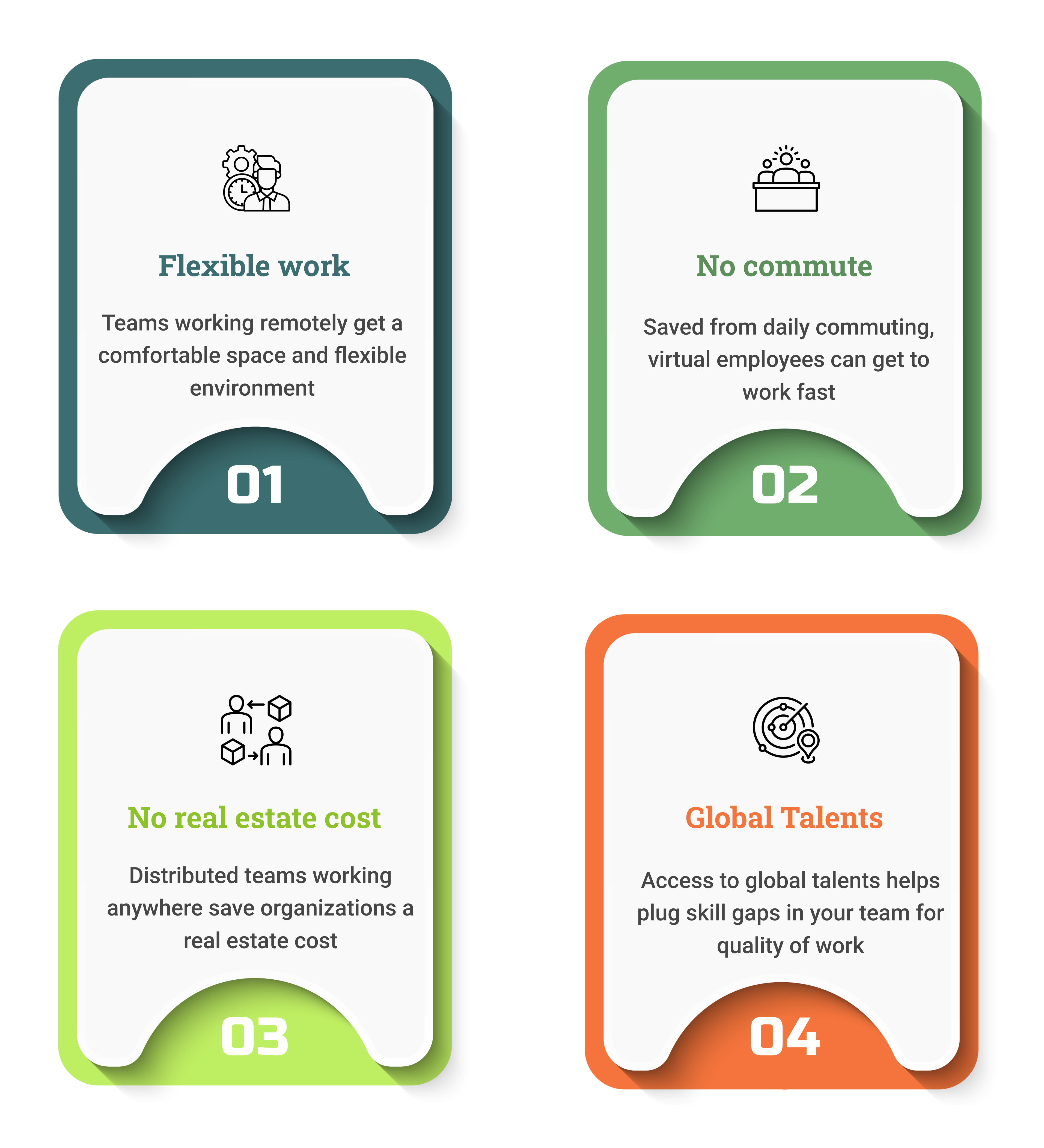With the growing shift to flexible work, workplaces are evolving and so are the workforces. This change once adopted for work continuity due to pandemic disruptions has transformed into a strategic advantage for organizations across the globe. Now when virtual has become the new work norm, the state of remote work in 2024 looks promising and is expected to strengthen its lead in subsequent years and beyond.
Table of Contents
Once came into existence out of a business continuity challenge, remote work is growing popular among organizations for the reasons it minimizes operational overheads and maximizes work-life balance. Stats also reveal that 71% of employees say remote work helps balance work and life. That trend adopted to navigate the pandemic is now widespread and being considered as a viable alternative to traditional office work. Organizations that have been hesitating in bringing remote work into practice now experiencing its multiple advantages. The growing distributed work has given rise to the virtual workforce that now can leverage the flexibility to work anywhere and with their comfort.
The potential of virtual workforce is significant in overcoming location barriers and working with talents worldwide. It also helps scale your business and expand access to new global markets by hiring native skills. Your organization with a digital workforce can gain immunity against work disruptions as we went through a few years back. The looming slowdown again hints at the worth of distributed teams to cut operational costs and continue business operations.
Remote work trends and predictions for 2024 reflect the importance of a virtual workforce and whether you operate with one defines how prepared your business is for future work challenges.
Responding to future work demands, your organization will support 65% of employees who want to work remotely all the time.
The impact of virtual workforce

Read More: Employee monitoring software with screenshots – Know how employees spend workday
Organizations with virtual workforce are in a better position to explore global markets and gain more business than those who run with traditional teams. Working in-office incurs additional costs with real estate/rent and utility bills while working remotely saves organizations from overhead expenses. Additionally, distributed work encourages better performance with cost benefits as the stats indicate:
– 35% of remote employees feel more productive working distributed
– $11000 employers can save by switching to remote work
– 32% of hybrid employees agree to a pay cut for full-time remote work
However, remote organizations have concerns about not knowing enough – how employees work, what are their productive hours, and whether their actions are compliant with business policy and data privacy. It reflects the need for a tracking tool as a study shows that 60% of companies use employee monitoring software for remote workforce management to stay aware of when distributed teams log into work, what tasks they perform and at what time, also control risky employee behavior to ensure secure business operations.
Why you need a virtual workforce
Apart from balanced work-life and cost advantages, a virtual workforce helps you eliminate the limitations of sourcing skills only from a specific region, working in confined office cubicles, wasting precious productive hours commuting, getting distracted by office noise and sudden check-in of any colleague.
With a virtual workforce, you can overcome limitations and explore better work opportunities:
Flexible work encourages high team morale
Teams working remotely get a comfortable space and flexible environment that motivates to optimize employee productivity than office work with confined space under direct monitoring of the management.
No commute time and low carbon footprints
Saved from daily commuting and the hassle of dealing with traffic and reaching the office on time, virtual employees can get to work fast and in a space of their comfort which helps them align their productivity in performing tasks rather than spoiling it with office commute – less commute equals less carbon footprint.
Work from anywhere negates real estate expenses
Distributed teams working anywhere other than the office save organizations a significant cost on real estate and infrastructure that they can better utilize in expanding teams and business.
Global skills complement teams and quality of work
Access to global talents helps plug the skill gap in your team and improves the quality of work. Seasoned skills employed at work enable you to better compete in the market and overcome the competition to win more business.
Explore global markets with native talents
With access to global talents, you can find native skills to serve your clients in their language and boost your credibility as one of the specialist service providers in any specific region.
Gain better immunity against work disruptions
Pandemic-caused work solution of a virtual workforce holds the potential to enable your organization to navigate work disruptions and continue operations.
2024 workforce predictions
The computer and IT sectors have been leading as top industries for remote work, and BPO is catching up fast. Technology-driven IT organizations can easily manage a distributed workforce and are expected to leverage remote work in 2024. BPOs are the biggest source of providing a virtual workforce to businesses and will continue facilitating outsourced virtual employees in 2024.
How AI can complement the virtual workforce
Emerging workforce trends for 2024 hint that more teams will embrace the future of work, and equally will grow the risk of compliance and data privacy breaches. Stats reveal the same as 73% of executives feel remote employees pose greater security risks. AI-based security and compliance monitoring enable BPOs and rest industries to ensure compliance with clean desk policy and business regulations at their workplace of the future.
Analyze employee data
Gain insights into how your virtual teams perform to manage efficiency at work. Capture the data about when they log into work, what tasks they do at what time, and with what productivity.
Read More: How to Evaluate Employee Quality of Work
Manage compliance in remote work
Measure how employees behave in distributed work environments to predict risks. Define AI-powered detections to control violations against business regulations and data privacy.
Ensure secure business operations
With security implementations like unauthorized employee detection, multiple persons around the workspace, and mobile use at work, businesses can negate potential data breach events to run secure operations.
Embracing the future of work
Future work 2024 predictions greatly favor virtual workforce for its multiple benefits and growing popularity. Organizations with remote teams gain the benefits of better aligning them with business goals, streamlining their workflows, finding seasoned talents across time zones, and reaching a wider customer base with shift management. There are bright chances remote work will catch more growth and we’ll see incrementing virtual workforce in 2024 and beyond. Start a free trial to support productivity and compliance in your future workplace.
Will work from home continue in 2024?
Many organizations see work from home as a potential alternative to office work for its added advantages of cost and work flexibility. The ongoing trend indicates continuous growth for the WFH norm.
What are the career trends in 2024?
The BFSI sector is strongly expected to lead with an anticipated 25% hiring intent. The expansion of talent acquisition in the financial industry hints at equal growth for tech and tool spending to regulate the work.
What is the fastest growing job in 2024?
With the growing positive outlook for job opportunities across multiple sectors, Healthcare support executive roles are expected to top the chart. It also indicates the need for security and compliance at work to control data privacy risks.
What will be the best jobs in 2024?
Among the top job opportunities for Augmented Reality (AR) and Virtual Reality (VR) developers, data security roles fall next and clues to the increasing demand for data privacy specialists.
Track Time, Productivity, Attendance & More
Ensure AI-powered compliance and streamline workforce management to drive data-backed decisions across teams with wAnywhere.
Setup in just 3 minutes on any device




